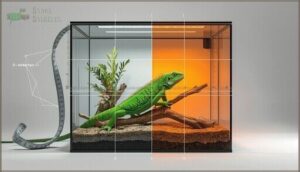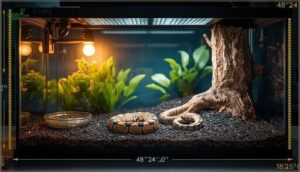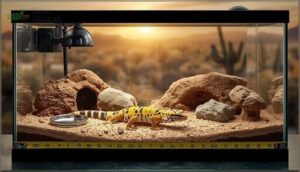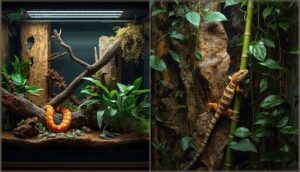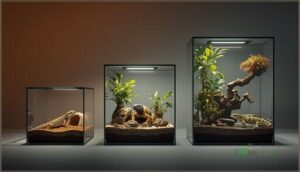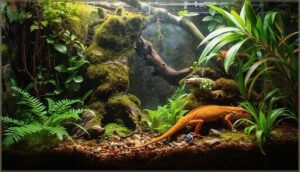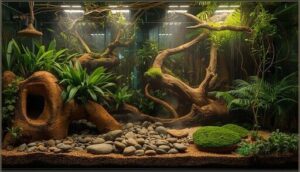This site is supported by our readers. We may earn a commission, at no cost to you, if you purchase through links.
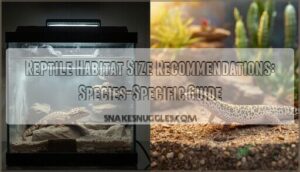
A leopard gecko curled in the corner of a 10-gallon tank isn’t just cramped—it’s physiologically compromised. Without adequate length to thermoregulate between zones or width to establish distinct behavioral territories, your reptile can’t perform the basic movements that maintain its metabolic health.
Reptile habitat size recommendations aren’t arbitrary numbers pulled from care sheets; they’re grounded in the biomechanics of how these animals move, regulate body temperature, and express natural behaviors. A ball python needs horizontal distance to stretch its spine fully after feeding. A bearded dragon requires vertical space to establish thermal hierarchies.
When you calculate dimensions for your enclosure, you’re not just buying a container—you’re designing a functional ecosystem where spatial geometry directly determines whether your animal thrives or merely survives.
Table Of Contents
- Key Takeaways
- Key Principles for Reptile Habitat Sizing
- How Enclosure Size Affects Reptile Welfare
- General Rules for Determining Enclosure Dimensions
- Terrestrial, Arboreal, and Semi-Aquatic Needs
- Recommended Sizes for Popular Reptile Species
- Sizing Guidelines for Small, Medium, and Large Reptiles
- Material Choices and Their Impact on Sizing
- Custom and Bioactive Enclosure Considerations
- Calculating Ideal Habitat Size for Your Reptile
- Essential Features for Healthy Reptile Habitats
- Frequently Asked Questions (FAQs)
- What makes a good reptile habitat?
- What size enclosure do Reptiles need?
- What are the different types of reptile enclosures?
- Where to buy a reptile tank online?
- Which Terrarium is best for pet reptiles?
- What is a custom PVC reptile enclosure?
- Can multiple reptiles share one larger enclosure?
- How often should enclosure size be upgraded?
- Do rescued reptiles need different sizing approaches?
- What permits are required for oversized enclosures?
- Conclusion
Key Takeaways
- Enclosure dimensions must prioritize length for horizontal thermoregulation, width for behavioral territory establishment, and height for arboreal species, with total volume directly impacting air quality, microclimate stability, and behavioral expression rather than mere containment.
- Undersized habitats trigger measurable physiological damage, including 50-200% elevated corticosterone levels, compromised immune function, respiratory infections from poor ventilation, and metabolic bone disease from inadequate UVB exposure zones.
- Species-specific minimums vary drastically—ball pythons require 48″×24″×24″ at maturity, bearded dragons need 6′×2′×2′, leopard geckos thrive in 20-30 gallon tanks, while monitors and tortoises demand room-sized custom enclosures with substrate depths exceeding 24 inches.
- Material selection fundamentally alters spatial efficiency and environmental control, with PVC retaining heat 20% longer than glass while weighing half as much, enabling vertical stacking that reduces floor space requirements by 30% in multi-enclosure setups.
Key Principles for Reptile Habitat Sizing
Choosing the right enclosure size isn’t just about fitting your reptile inside—it’s about giving them room to live the way they’re wired to. The dimensions you select directly influence how well your animal can regulate its body temperature, move freely, and express instinctive behaviors that keep it healthy.
Enclosure size isn’t about containment—it’s about giving your reptile the space to thermoregulate, move, and behave as instinct demands
Let’s break down the core principles that should guide every habitat decision you make.
Importance of Length, Width, and Height
Understanding reptile enclosure size starts with dimensional balance. Each measurement plays a distinct role in habitat creation and design:
- Length allows full-body extension and horizontal reptile movement patterns
- Width provides activity breadth and space requirements for thermoregulation
- Height supports vertical exploration for arboreal species
- Combined dimensions create environmental gradients essential for health
- Proper ratios enhance reptile enclosure design across terrestrial and climbing lifestyles
Reptile owners must consider reptile enclosure guidelines for a healthy environment.
Role of Total Volume in Habitat Health
Total volume in your reptile enclosure directly shapes air quality, behavioral health, and microclimate stability. Larger volumes improve oxygen exchange while reducing ammonia buildup, protecting respiratory function.
You’ll notice enhanced behavioral expression as your reptile explores discrete thermal zones within the habitat creation and design. Volume effects extend to thermoregulation—ample space maintains stable gradients, supporting digestion and immune response.
Proper reptile habitat design prioritizes volumetric calculations alongside floor dimensions for ideal reptile health and enclosure size planning. Reptile owners should research ideal enclosure size guides to guarantee the best environment for their pets.
Impact on Thermoregulation and Behavior
When your reptile can’t access distinct temperature zones, thermal stress compromises immune function and metabolic efficiency. Proper habitat design with environmental gradients lets your reptile move between microclimates, supporting thermoregulation and reptile welfare.
Undersized enclosures limit behavioral patterns—snakes can’t stretch fully, lizards abandon natural basking routines. Species-specific requirements for reptile enclosure size directly influence reptile behavior and long-term health outcomes.
How Enclosure Size Affects Reptile Welfare
The size of your reptile’s enclosure isn’t just about fitting them inside—it’s about giving them the space they need to thrive physically and mentally. When enclosures fall short of minimum requirements, you’ll see behavioral changes, compromised health, and chronic stress that can shorten your reptile’s lifespan. Understanding these welfare impacts will help you make informed decisions about proper habitat sizing.
Stress Reduction Through Adequate Space
When your reptile paces along glass walls or displays repetitive head-bobbing, it’s signaling that something’s wrong. Adequate enclosure size directly reduces physiological stress markers and transforms reptile health:
- Heart rates stabilize when reptiles can fully stretch and patrol environmental gradients
- Corticosterone levels—your primary stress assessment tool—drop by 50-200% with proper space optimization
- Immune function strengthens, protecting against disease and reproductive complications
- Behavioral diversity increases as species-specific care allows natural movement patterns
Larger reptile enclosures eliminate stereotypic behaviors while supporting thermoregulation and reptile enrichment across all activity zones.
Encouraging Natural Behaviors
Proper sizing unlocks your reptile’s natural repertoire—arboreal species climb vertical structures, terrestrial types patrol thermal gradients, and burrowers excavate substrate layers when habitat complexity underpins species-specific care.
Environmental gradients within spacious enclosures promote natural locomotion patterns, from stretching behaviors in snakes to foraging movements in lizards.
This behavioral enrichment prevents repetitive actions while supporting reptile behavior and psychology through animal enrichment strategies that mirror wild habitat complexity and promote authentic reptile enclosure design.
Health Risks of Undersized Enclosures
When your reptile lacks adequate space, physiological consequences cascade through multiple organ systems—you’ll observe muscle atrophy from restricted movement, elevated stress hormones compromising immune function, and stunted growth from inadequate thermoregulation zones.
Undersized reptile enclosures directly threaten reptile health through:
- Respiratory infections from poor ventilation and moisture accumulation in cramped spaces
- Metabolic bone disease when insufficient area limits UVB exposure and calcium metabolism
- Infection risks escalating as fecal buildup concentrates pathogens in confined quarters
- Metabolic slowdown disrupting digestion when basking opportunities decrease
- Skeletal deformities developing when species-specific requirements for natural movement patterns aren’t met
General Rules for Determining Enclosure Dimensions
You can’t simply eyeball enclosure size and hope for the best—calculating proper dimensions requires a methodical approach grounded in your reptile’s adult measurements and behavioral needs. While exact requirements vary by species, several universal formulas help you establish baseline dimensions that support thermoregulation, movement, and psychological well-being.
Let’s examine the foundational sizing principles that apply across most reptile groups.
Common “Rule of Thumb” for Sizing
You’ll often hear that your reptile’s enclosure length should match or exceed its full adult body length—this length-to-animal ratio forms the foundation of species-specific care. Minimum dimensions generally start at 1× body length, though alternative guidelines suggest two-thirds or three-quarters for some species.
Large reptiles like ball pythons benefit most from generous enclosure size, with welfare benefits clearly documented when exceeding these baseline enclosure design and size standards.
Measuring Adult Reptile Size
Before you can apply any enclosure size rule, you need accurate adult measurements—because a bearded dragon stretches nearly twice as long as a leopard gecko. Different reptile species require different measurement techniques:
- SVL measurement (snout to vent) works best for lizards and some turtles, capturing body length without tail variability
- Total length matters most for snakes and monitors, influencing species-specific care standards
- Shell length determines enclosure design and size for tortoises and aquatic turtles
Flexible measuring tape following body contours delivers the most accurate methods, while shed skins overestimate by 10-30%.
Adjusting for Growth and Life Stage
Your reptile won’t stay hatchling-sized forever—ignoring growth milestones leads to stunted growth and health risks. Juvenile upgrades should happen every 6–12 months as your animal matures, with enclosure size doubling for species like bearded dragons during rapid first-year development.
| Life Stage | Upgrade Frequency | Space Increase |
|---|---|---|
| Hatchling (0-6 months) | Every 6 months | 50-100% |
| Juvenile (6-18 months) | Every 6-12 months | 100-200% |
| Adult (18+ months) | As needed | Final size |
Arboreal adjustments require vertical expansion proportional to tail length, while terrestrial reptile species need floor space matching body length. Monitor pacing behavior and restricted movement—these signal immediate resizing needs for best reptile care across species-specific care requirements in any reptile habitat.
Terrestrial, Arboreal, and Semi-Aquatic Needs
Your reptile’s lifestyle determines which dimensions matter most in their enclosure. Ground-dwelling species need generous floor space to roam and thermoregulate, while climbers require vertical height with stable fixtures.
Semi-aquatic reptiles pose a particular difficulty—you’ll need to balance adequate land area with sufficient water volume for swimming and hydration.
Floor Space for Ground-Dwelling Species
Ground-dwelling species need generous floor space—think of it as their entire world compressed into one plane. You should maintain at least 30-40% open movement area for natural behaviors like patrolling temperature gradients and burrowing.
Essential floor space considerations for terrestrial reptile care:
- Enclosure size: Length should equal your reptile’s adult size, width at two-thirds minimum
- Temperature gradient: Sufficient floor area allows proper basking-to-cool zones
- Substrate depth: Factor in burrowing space without reducing usable surface area
- Enrichment density: Place hides strategically while preserving open pathways
- Group housing: Increase floor space 10% per additional reptile for species-specific care
For example, a 50-cm bearded dragon thrives in 120×60 cm dimensions, supporting exercise and thermoregulation.
Vertical Space for Climbing Reptiles
While ground dwellers patrol horizontal zones, arboreal species thrive upward. You’ll need height at least 1.5 times your reptile’s body length—crested geckos require 36 inches minimum, and chameleons need double their adult length. Climbing structure safety is crucial: secure branches prevent falls, while multiple platforms increase behavioral diversity.
Vertical terrariums significantly improve welfare. Studies show that climbing reptiles exhibit reduced anxiety and explore more when height matches species-specific requirements. This setup also prevents height-related health risks, such as obesity and stress.
| Species | Minimum Vertical Height |
|---|---|
| Crested Gecko | 36 inches (91 cm) |
| Chameleon | 2× adult body length |
| Gargoyle Gecko | 60 inches (1.5 m) |
| Corn Snake (adult) | Allows climbing exploration |
Land and Water Balance for Semi-Aquatics
Semi-aquatic species need careful water quality management and land features to thrive. Your reptile enclosure should allocate space based on species needs—most semi-aquatics follow this ratio:
- Water occupies 50–75% of total enclosure size for swimming
- Land comprises 25–50% for basking platforms and thermoregulation
- Water depth equals shell length for submersion safety
- Minimum 10 gallons per inch of shell bolsters turtle health
- Species-specific care determines best land-water proportions
Monitor humidity levels and filtration to prevent disease.
Recommended Sizes for Popular Reptile Species
You need species-specific dimensions to build a habitat that actually works. Different reptiles have wildly different space requirements based on their size, behavior, and how they move through their environment.
Here’s what you should plan for four of the most commonly kept species.
Ball Python Enclosure Dimensions
Your ball python needs at least 48″ × 24″ × 24″ once it exceeds three feet. Minimum dimensions like these support thermoregulation and enrichment needs through strategic heating placement and humidity control.
Juvenile specimens start smaller—around 10 gallons—but you’ll upgrade as they mature. Substrate depth, generally 2–3 inches, complements enclosure design by facilitating burrowing behavior.
Species-specific requirements dictate that larger reptile enclosures improve activity patterns and overall welfare.
Bearded Dragon Habitat Requirements
Your bearded dragon demands at least 6′ × 2′ × 2′ for best reptile care and maintenance—larger than previous species-specific requirements. Vertical space of 3 feet accommodates natural behaviors, while substrate options like tile or topsoil help with digging.
These dimensions support temperature gradients, lighting needs, and enclosure enrichment through climbing structures. Proper reptile enclosure size with ventilation design prevents respiratory issues.
Current standards reflect advancing welfare science for bearded dragon habitats.
Leopard Gecko Minimum Tank Size
A single adult leopard gecko thrives in a 20-gallon long tank, measuring roughly 30 inches in length—smaller reptile enclosures invite stress and territorial disputes. Hatchling enclosures can start smaller, but you’ll move them as they mature.
Consider these species-specific requirements for ideal leopard gecko care:
- Minimum 10 gallons for juveniles; 20-30 gallons for adults
- Tank height matters less than floor space for these terrestrial species
- Cohabitation concerns demand 30+ gallons to reduce aggression
- Bioactive setups require additional depth for substrate layers
- Enrichment needs include hides, climbing branches, and thermal gradients
Proper reptile habitat sizing aids natural behaviors and long-term health.
Corn Snake and Crested Gecko Needs
Adult corn snakes need 48″ x 24″ x 24″ enclosures minimum—their semi-arboreal nature demands vertical space for corn snake climbing behavior.
Crested geckos require 18″ x 18″ x 36″ as adults, with hatchlings starting in 12″ cubes. Gecko vertical space directly impacts muscle tone and health. Larger dimensions like 24″ x 24″ x 48″ support arboreal enrichment and humidity gradients.
Never attempt species cohabitation without doubling enclosure size and monitoring territorial stress.
Sizing Guidelines for Small, Medium, and Large Reptiles
Understanding how enclosure size scales with reptile body size helps you make informed housing decisions from the juvenile stage through adulthood. Small species like leopard geckos have different spatial needs than medium-sized bearded dragons or large monitors and tortoises.
The following guidelines break down minimum and preferred enclosure dimensions based on your reptile’s size category, activity patterns, and growth trajectory.
Juvenile Vs. Adult Enclosure Recommendations
You’ll need different enclosures as your reptile matures—think of it as upgrading their living quarters to match their changing needs. The timing of this move depends on growth milestones and behavioral changes indicating spatial restriction.
Key move guidelines for proper reptile care:
- Small reptiles (leopard geckos): Start with 20-gallon tanks, upgrade to 36×18×12 inches as adults
- Medium reptiles (bearded dragons, corn snakes): Begin at 36×18×18 inches, expand to 48×24×24 inches minimum at maturity
- Large reptiles (ball pythons): Juveniles need 30-gallon enclosures; adults require 4×2×2 feet for species-specific care and space enrichment
Moving your reptile to adult-sized reptile habitats when they reach two-thirds adult size prevents health impacts from undersized reptile enclosures.
Adjusting Size for Activity Level
Your reptile’s activity level demands adaptable habitat design—a snake that patrols nightly needs 1.5 times the standard enclosure size for welfare-driven adjustments.
Flexible enclosure sizing ensures behavioral space needs are met: highly active species show 35% more natural behaviors when given activity-based enrichment zones.
Match your reptile species to its movement patterns for ideal species-specific care and animal enrichment.
Special Considerations for Monitors and Tortoises
Monitor lizards and tortoises defy typical reptile habitat formulas—you’re looking at room-sized commitments rather than glass boxes.
Consider these species-specific adjustments for best enclosure size:
- Ackie monitors require 5×2.5×4-foot habitats minimum, with 24-inch monitor substrate depth for natural burrowing behavior
- Russian tortoises thrive in tortoise outdoor pens offering 24.5 square feet of roaming space
- Activity space effects include 35% increased natural behaviors and reduced stress biomarkers
Custom enclosure benefits outweigh standard tanks—larger reptile habitat dimensions directly improve thermoregulation and welfare outcomes.
Material Choices and Their Impact on Sizing
The material you choose for your reptile’s enclosure doesn’t just affect aesthetics—it directly influences thermal regulation, humidity retention, and how efficiently you can use available space. Different materials create distinct microclimates and require different sizing approaches to achieve the same environmental stability.
Let’s examine how PVC, glass, and wood compare in terms of optimizing your habitat’s dimensions and performance.
PVC Vs. Glass Vs. Wood Enclosures
When choosing between PVC enclosures, glass enclosures, and wood enclosures, you’re fundamentally selecting the foundation for your reptile enclosure’s thermal stability and longevity. Each material dramatically affects enclosure size efficiency and environmental control.
| Material | Heat Retention | Durability Factors |
|---|---|---|
| PVC Enclosures | Retains heat 20% longer than glass | Lasts 20-30 years; rot-resistant |
| Glass Enclosures | Poor insulation; rapid heat loss | Fragile; prone to cracks |
| Wood Enclosures | Excellent natural insulation (R-value 1.1) | Susceptible to warping and rot |
PVC offers exceptional moisture control and weight comparison advantages—it’s less than half the weight of glass—while providing better customization options than traditional glass tanks.
Insulation and Moisture Control Factors
Beyond material selection, thermal insulation and humidity management determine how well your reptile enclosure maintains stable microclimates. PVC reduces heat loss by 25–40% compared to glass, while wood retains heat up to 30% better—translating directly into lower energy costs and consistent temperature gradients.
Effective moisture retention involves three factors:
- Substrate depth (4–6 inches in humidity zones)
- Enclosure sealing (reduces humidity loss by 15%)
- Strategic placement of water features near moisture zones
Proper climate control prevents the 35% increase in shedding problems linked to inadequate insulation.
Choosing The Best Material for Space Optimization
When space is at a premium, PVC lightweighting offers unparalleled stackability options and thermal efficiency—you’ll use 30% less floor area by stacking multiple reptile enclosure units vertically. Glass visibility suits display-focused setups but sacrifices portability. Wood customization excels in habitat creation for terrestrial species, while acrylic scratching limits long-term clarity in high-traffic terrariums.
| Material | Best For | Space Efficiency |
|---|---|---|
| PVC | Multi-enclosure setups | High (stackable, lightweight) |
| Glass | Single display habitats | Moderate (heavy, static) |
| Wood | Custom terrestrial builds | High (customized dimensions) |
Custom and Bioactive Enclosure Considerations
When standard enclosures don’t quite fit your reptile’s needs or your vision for a naturalistic habitat, custom and bioactive setups offer powerful alternatives. These approaches let you expand space efficiency while creating self-sustaining environments that benefit both your animal’s welfare and your maintenance routine.
Let’s look at how custom sizing, bioactive design, and smart technology can transform your reptile’s living space.
Benefits of Custom-Sized Habitats
Flexibility stands at the heart of custom reptile enclosures, allowing you to address species-specific requirements with precision. These habitats support behavioral welfare through enrichment zones designed to fit and enclosure size that’s just right, reducing stress by 18% compared to standard tanks.
You’ll notice improved health outcomes as your reptile exhibits natural behaviors—growth optimization and habitat creation become achievable when dimensions match your animal’s unique needs.
Bioactive Setup Space Requirements
Living ecosystems transform enclosure size requirements dramatically—your bioactive terrarium setup demands roughly three times the standard reptile habitat volume to sustain waste cycling effectively. You’ll need substrate depth of 4-6 inches layered with drainage material, plus microfauna volume adequate for establishing cleanup crews.
Consider these spatial additions:
- Drainage layer foundation (1+ inch LECA or lava rock)
- Plant rooting zones requiring deeper organic substrate
- Microfauna volume sufficient for colony establishment
- Additional 30-50% volume benefits beyond non-bioactive minimums
- Enhanced vertical space for gradient creation
Larger bioactive enclosures support multiple microclimates critical for thermoregulation while preventing pathogen buildup through proper waste separation zones.
Incorporating Smart Technology for Environment Control
When environmental control systems interface with properly sized enclosures, you’ll transform habitat maintenance through remote monitoring and automated adjustments. Smart alerts notify you instantly of temperature or humidity deviations, while species customization presets match your reptile’s exact requirements. Data integration tracks long-term trends, optimizing environmental control for species-specific requirements within your reptile enclosure.
| Technology Feature | Enclosure Size Benefit |
|---|---|
| Remote monitoring sensors | Validates maintaining environment across larger volumes |
| Automated climate zones | Creates thermal gradients in spacious enclosures |
| Smart alerts | Prevents failures regardless of enclosure size |
| Species customization | Tailors parameters to species-specific requirements |
| Data integration | Optimizes environmental control through analytics |
Calculating Ideal Habitat Size for Your Reptile
You’ve explored the principles behind habitat sizing—now it’s time to translate those concepts into concrete dimensions for your specific reptile. Calculating the right enclosure size isn’t guesswork; it requires precise measurements of your animal, careful attention to its behavioral needs, and sometimes a bit of math to make certain of adequate volume and spatial arrangement.
The following guidelines will walk you through the measurement process, introduce helpful calculation tools, and show you how to factor in the environmental variables that make a habitat truly functional.
Measuring Length, Width, Height, and Volume
You need dimensional accuracy to guarantee your reptile habitat meets species-specific requirements. Measure interior length, width, and height with digital tape or laser tools—standardized units prevent errors.
Calculate volume using length × width × height formulas, then subtract 15–25% for substrate adjustment and décor to determine effective space.
Tool calibration matters: multiple measurements across enclosure points confirm proper sizing for species-specific care standards.
Using Online Enclosure Size Calculators
Online enclosure size calculators simplify species-specific care by accepting input parameters like adult length, habitat type, and activity level. Calculator accuracy depends on validation methods rooted in husbandry standards, so you should cross-reference outputs with published care sheets for your reptile species.
Custom features—such as adjusting for arboreal versus terrestrial needs—help improve recommendations, ensuring your reptile enclosure meets species-specific requirements beyond generic formulas.
Factoring in Environmental and Behavioral Needs
Thermoregulation zones spanning 30–40°C and environmental complexity determine how your reptile uses its enclosure size. You’ll need distinct hiding spots—studies show reptiles use these 2.3 times more often in complex setups—along with behavioral enrichment that matches species-specific requirements.
Activity levels rise 42% when environmental features support natural behaviors, making structural elements as critical as square footage for animal enrichment and species-specific care.
Essential Features for Healthy Reptile Habitats
Once you’ve determined the right size for your reptile’s enclosure, you need to equip it with the features that support health and natural behavior. The physical space matters, but without proper ventilation, lighting, substrate, and enrichment, even a large habitat won’t meet your animal’s needs.
Here’s what every well-designed enclosure should include to create a functional, thriving environment.
Ventilation and Air Exchange
Your reptile enclosure needs proper ventilation to safeguard respiratory health and prevent mold growth. Strategic vent placement—low on the cool side, high on the warm side—drives natural airflow patterns that regulate humidity control and support odor reduction. Screens or mesh tops improve air exchange without creating drafts.
These species-specific requirements vary by enclosure size, but adequate ventilation remains non-negotiable for reptile habitat health and long-term reptile health outcomes.
Lighting and Heating for Size-Appropriate Enclosures
Lighting and heating elements must align with enclosure size to establish functional thermal gradients. You’ll need to match wattage requirements to your habitat’s volume—PVC retains heat better than glass, reducing energy costs. Material influence matters: well-insulated enclosures need roughly 50% less wattage.
- UVB penetration decreases with distance in taller tanks
- Temperature gradient zones depend on floor area and reptile species
- Energy efficiency improves with thermostatic control and proper bulb placement
Substrate, Water Features, and Enrichment Items
Once lighting and heat are right, focus shifts to how every inch of your reptile enclosure benefits your animal’s health. The depth of substrates determines burrowing opportunity and substrate impaction risk, while balanced water feature sizing aids hydration. Enrichment item placement makes all the difference—bioactive substrate health and behavioral enrichment benefits are central, shaped by enclosure size and reptile species.
| Feature | Practical Tip | Species Sensitivity |
|---|---|---|
| Substrates | Keep depth species-specific | Desert vs. tropical needs |
| Water Feature Sizing | Use 20%-50% of floor area | Semi-aquatic reptiles |
| Enrichment Placement | Guarantee open movement, easy access | Arboreal vs. terrestrial |
Frequently Asked Questions (FAQs)
What makes a good reptile habitat?
A quality enclosure balances environmental control with behavioral enrichment. You’ll need proper heating gradients, humidity management, secure construction for safety, and sufficient space allowing natural movement—all adapted to your species-specific requirements.
What size enclosure do Reptiles need?
Your reptile’s enclosure size depends on species-specific requirements, adult body length, and activity level. Terrestrial species need expansive floor space, while arboreal reptiles require vertical climbing room for proper behavior and thermoregulation.
What are the different types of reptile enclosures?
You’ll find diverse options for reptile enclosures, ranging from efficient PVC enclosures and classic glass terrariums to screen cages for airflow, durable wooden vivariums, and practical plastic tubs—each shaping terrarium and vivarium design, care, and enclosure size.
Where to buy a reptile tank online?
You’ve got options galore when selecting terrariums—Pangea Reptile, Zen Habitats, and ReptiZoo.store deliver online store variety, material availability online, pricing and deals, plus customer service and shipping reliability for every reptile enclosure size you’ll need.
Which Terrarium is best for pet reptiles?
The best terrarium depends on your reptile enclosure needs. PVC optimizes space utilization and moisture control, glass offers visibility, while wood provides better insulation.
Match enclosure material to your species-specific requirements and budget considerations.
What is a custom PVC reptile enclosure?
A custom PVC reptile enclosure is a habitat crafted from insulating polyvinyl chloride, designed to your reptile’s specific dimensions and needs.
It offers enhanced thermal retention, moisture resistance, and precise customization options unavailable in standard glass terrariums.
Can multiple reptiles share one larger enclosure?
Cohabitation risks outweigh benefits for most reptiles. Species compatibility is rare, and aggression signs emerge even in larger enclosures.
Space requirements double per animal, yet stress persists. Prioritize solitary housing unless breeding carefully monitored, compatible species temporarily.
How often should enclosure size be upgraded?
You should upgrade your reptile’s enclosure every 6–12 months during rapid juvenile growth, then annually for adults.
Monitor behavioral upgrade indicators like pacing or restricted movement—these signal immediate upgrade frequency factors beyond scheduled growth point reviews.
Do rescued reptiles need different sizing approaches?
Rescued reptiles require rehabilitation sizing trends that prioritize stress reduction, space, and welfare-critical cases. You’ll need enclosures exceeding standard minimums—often 10–50% larger—to support reptile health during recovery and post-release preparation.
What permits are required for oversized enclosures?
You’ll usually need state wildlife permits and possibly local zoning approval for oversized enclosures.
The application process varies by jurisdiction, with species restrictions, enclosure standards, and fees depending on your reptile’s size and species-specific requirements.
Conclusion
Your reptile’s skeleton doesn’t compress to fit a budget enclosure—it adapts through chronic stress, metabolic dysfunction, and stunted behavior. When you apply these reptile habitat size recommendations, you’re not indulging your animal; you’re meeting the non-negotiable spatial thresholds that separate captive survival from genuine welfare.
Measure twice, build once, and design from your reptile’s anatomy outward. The difference between adequate and inadequate space isn’t visible in a photograph—it’s written in your animal’s physiology.
- https://www.stumpscustomwood.com/keeping-up/find-the-perfect-fit-your-reptile-enclosure-size-guide
- https://ned.apes.org.uk/books/general-reptile-care-and-rules/page/uk-guide-to-reptile-enclosure-sizes-general-rules-metrics-and-species-specific-recommendations/export/pdf
- https://www.familyreptiles.com/post/what-size-tank-or-enclosure-does-my-reptile-need-as-it-grows
- https://talis-us.com/pt/blogs/blog-175/essential-reptile-enclosure-size-guide-for-healthy-pets
- https://www.reptileforums.co.uk/


